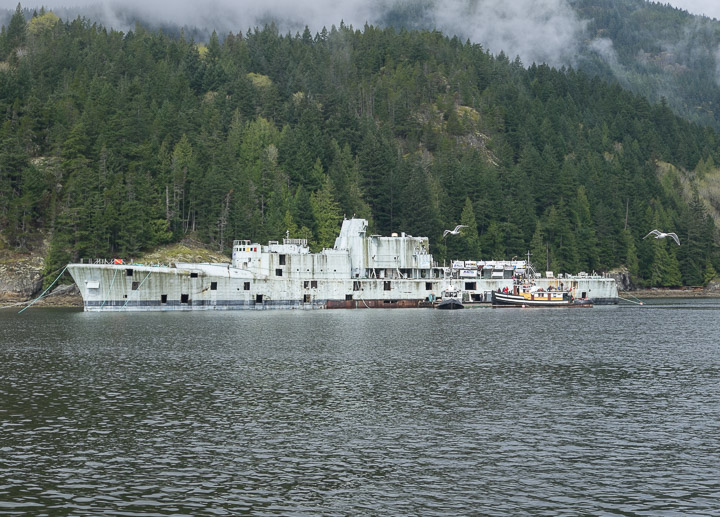
Sinking the Annapolis

On April 4th, the Artificial Reef Society sank a navy ship; we were in the (floating) audience. I’ve never seen anything like it.
Here’s the Annapolis, a former Canadian navy destroyer built in 1961, just prior to sinking.
As the photo suggests, this is a nice little corner of the world. It’s called Halkett Bay, and the view is nice whichever way you look.
And as that photo suggests, boy were there ever a lot of miscellaneous boats on hand.
We were rafted to a boat moored to a big barge being used by the TV cameras, and there were three more boats rafted onto us. We climbed up onto the TV barge without asking anyone’s permission, and thus had about the best view possible.
Since the sinking was scheduled for 12:30PM (slack tide), nautical lunches were called for. Here was the next boat over’s.
Ours was tasty too, but didn’t include whiskey.
Here is a tweet with an aerial view of the whole scene; it’s worth a look.
Here’s one of the last guys on board.
The charges were fired from the little tugboat visible at right. As they motored away you could see them paying out detonation wires. There were four shockingly loud bangs, puffs of smoke, and a tiny flash of flame.
If you zoom in you might be able to see the two brooms sticking up from the highest point on the Annapolis. This I guess would be the clean sweep signal.
The boat sank slowly initially, and dead-level, as they’d hoped.
The water’s about 100 feet deep there. That little bay had been used for log booms for a long long time, and as a result its bottom is currently pretty sterile, mostly logging detritus, not much living there. The hope is that the Annapolis will be, as they say, an artificial reef, teeming with life.
Some environmentalists and local cottagers were concerned about the effect of naval paint, and mounted a sustained legal battle against the sinking. But they lost in both the courts of law and public opinion. The local First-Nations tribes and several levels of government (notably the Navy, which provided the Annapolis) were big supporters of the event.
As the main deck approached the surface, water and smoke blew out of the hatches.
They’d gone to great lengths to have it settle as right-side-up as possible. They were specifically worried about going down excessively stern-first. And in fact that did happen, to some extent.
But afterward, the organizers were jubilant, toasting each other and exchanging high-fives, so I guess they got more or less what they wanted. If you’re a diver, now you can visit the Annapolis on the ocean floor, starting today, within 24 hours of sinking. I’m not, but if I were I would.
Videos · There’s a nice professionally-shot high-def capture at Vimeo; I recommend going full-screen. But Lauren has an amateur version shot from among the crowd on the TV-camera barge which has way better audience-participation audio. The little-girl voice is my daughter’s.